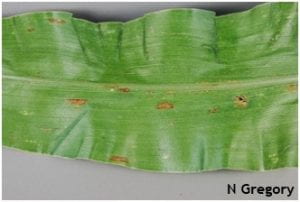Nathan Kleczewski, Extension Specialist – Plant Pathology; nkleczew@udel.edu
Growers and scouts are reporting gray leaf spot (GLS) in our area and we confirmed this disease on corn sent to the University of Delaware Plant Diagnostic Clinic last week. This is of little surprise since conditions have been ideal for development of this disease. GLS is one of the more common diseases of corn in Delaware and is considered to be the most destructive disease of corn worldwide.
GLS is caused by Cercospora zeae maydis, a fungus that does very well under warm, humid conditions. The fungus overwinters on corn debris and is moved to plants through wind and/or rain. As a result, the disease appears on the older or lower leaves first. Once infected, plants take time to develop symptoms of the disease. Symptomatic leaves have small, tan, rectangular lesions (1/8 to 1/2 inch wide x 1/2 to 2 inches long) often surrounded with yellow halos (Figures 1 and 2). As lesions develop they become long, narrow, and rectangular. Lesions can grow up to 3 inches long and are delimited by the leaf veins, which results in sharp, parallel lesion edges. With time these regions of the leaf can form large necrotic areas. Lesion color can differ from shades of brown to tan depending on the corn hybrid. Yield reductions caused by this disease are minimal if the symptoms do not reach above the ear leaf. If susceptible hybrids are planted, losses can approach 25% when spotting reaches above the ear leaf by the milk stage. Losses decrease as the plants reach the hard dough stage. Scouting fields for the disease throughout the growing season, particularly in warm muggy weather is central in within-season management of the disease. Scouts should pay particular attention to the lower three leaves of the corn plant from the period just before tasseling to two weeks after tasseling.
GLS is a very difficult disease to control, but integration of management practices can help reduce disease risk and the potential for severe losses. Resistant hybrids are the first line of defense. Companies have several resistant varieties to choose from, although keep in mind that resistant varieties are not immune to GLS. Instead, you can expect the disease to develop more slowly, which will reduce yield losses. Corn is the only known host of GLS, so crop rotation will help reduce inoculum. Plowing/tillage, where appropriate, will also help reduce overwintering inoculum by burying it beneath the soil surface and reducing spore production. If the problem begins near the ear leaf, fungicide applications can help. There are several fungicides labeled for control of GLS (refer to the Corn Fungicide List, included in the June 28, 2013 issue of WCU and the Field Crops Disease Management Blog http://extension.udel.edu/fieldcropdisease/category/corn/). Timing of these products (typically between VT to R2) is important. Profitability of a fungicide application will depend on factors that affect disease severity and yield (susceptibility of hybrid, disease pressure, and environmental conditions).
More information on yield losses resulting from Gray Leaf Spot and decision trees for fungicide applications can be found on the Field Crops Disease Management Blog available from the UD Extension website. http://extension.udel.edu/fieldcropdisease/
Other recent topics include: Wheat test weights, sooty mold, and sprouting; Misconceptions around management of Fusarium head blight; Handling Fusarium infested grain; Increasing double soybean yield and more.
 Figure 1. Early symptoms of gray leaf spot on corn.
Figure 1. Early symptoms of gray leaf spot on corn.
 Figure 2. Lesions of gray leaf spot with characteristic rectangular shape and chlorotic halos.
Figure 2. Lesions of gray leaf spot with characteristic rectangular shape and chlorotic halos.
